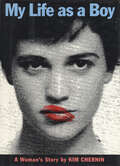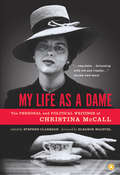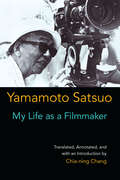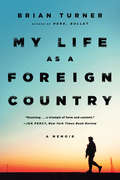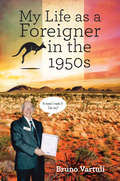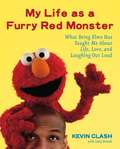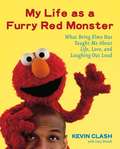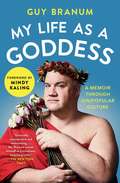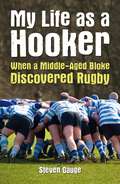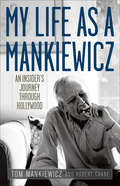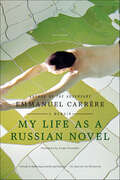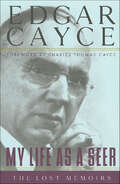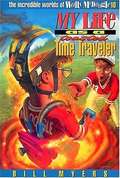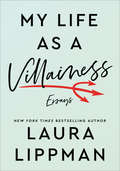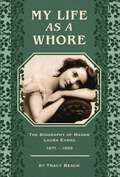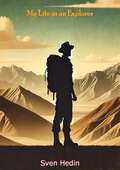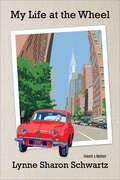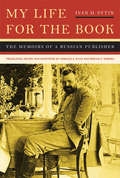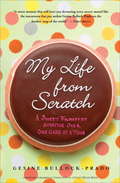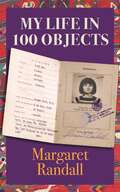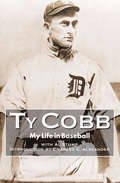- Table View
- List View
My Life as Eva: The Struggle is Real
by Eva GutowskiFrom the popular YouTube tastemaker Eva Gutowski comes a unique lifestyle and advice book on the ups and downs of life in her hilarious and earnest voice.What’s up guys? It’s me, Eva! You may know me from my YouTube channel, MyLifeasEva. If that’s the case, then you might also know that I have a munchkin cat named Paris, a weird obsession with patterned sock collecting, and the tendency to say “HOLY SCHNITZEL!” at all the wrong moments. Like...embarrassing moments. I’m so lucky to have my fans—over seven million besties and counting! It has been amazing to meet so many of you since I started making videos. Growing up, books are what got me through life—a lot of the good times, and the really really bad times. And no matter how challenging life got, I promised myself that I would get through it, in hopes that someday I’d have the chances to help people who need that one piece of great advice, at just the right time. So here’s a book by me, totally for you. I’ll tell you a ton of my secrets, a lot of fail stories, and how I made it through—and you can too! Think of my book like a best friend you can turn to at any time. Xo Eva
My Life as a Boy: A Woman's Story
by Kim CherninBy turns provocative and startlingly revealing, MY LIFE AS A BOY is the story of a woman trying to figure out what love is, trying to understand what happens between desire and the determination to possess the object of that desire, and discovering what it's like to go after what you want. "Chernin writes with the grace of a poet and the insight of a psychotherapist, bringing the shape-shifting nature of intimate relationship alive."--San Francisco Examiner and Chronicle
My Life as a Dame: The Personal and Political Writings of Christina McCall
by Christina McCallIn February 1956, a remarkable young woman named Christina McCall began her working life as an editorial secretary at Maclean's magazine. It was a legendary time there, when the likes of Pierre Berton, Robert Fulford, June Callwood, Peter Gzowski, and Peter C. Newman graced the magazine's pages. McCall would come to join that illustrious group, and be considered not only one of the best political writers of her generation, but a pioneer for women in journalism and one of Canada's most brilliant minds. For the first time, the best of McCall's articles and essays have been collected in one definitive volume alongside excerpts from her unfinished memoirs. Covering topics from the Alberta oil boom to the rise of divorce rates in Canada to in-depth profiles of the Ottawa establishment, McCall's clear-eyed observations are not only laced with insight, humour, and compassion, they continue to be relevant today.
My Life as a Filmmaker
by Chia-Ning Chang Satsuo YamamotoIn his posthumous autobiography, Watakushi no eiga jinsei (1984), Yamamoto reflects on his career and legacy: beginning in the prewar days as an assistant director in a well-established film company under the master Naruse Mikio, to his wide-ranging experiences as a filmmaker, including his participation in the tumultuous Toho Labor Upheaval soon after Japan’s defeat in World War II and his struggles as an independent filmmaker in the 1950s and 1960s before returning to work within the mainstream industry. In the process, he established himself as one of the most prominent and socially engaged film artists in postwar Japan. Imbued with vibrant social realism and astute political commentary, his filmic genres ranged widely from melodramas, period films from the Tokugawa era, samurai action jidaigeki, social satires, and antiwar films. Providing serious insights into and trenchant critique of the moral corruption in Japanese politics, academe, industry, and society, Yamamoto at the same time produced highly successful films that offered drama and entertainment for Japanese and international moviegoers. His considerable artistic distinction, strong social and political consciousness, and filmic versatility have earned him a unique and distinguished position among Japan’s world-class film directors. In addition to detailed annotations of the autobiography, translator Chia-ning Chang offers a comprehensive introduction to the career and the significance of Yamamoto and his works in the context of Japanese film history. It contextualizes Yamamoto’s life and works in the historical and cultural zeitgeist of prewar, wartime, and postwar Japan before scrutinizing the unique qualities of his narrative voice and social conscience as a film artist.
My Life as a Foreign Country: A Memoir
by Brian TurnerA war memoir of unusual literary beauty and power from the acclaimed poet who wrote the poem "The Hurt Locker." In 2003, Sergeant Brian Turner crossed the line of departure with a convoy of soldiers headed into the Iraqi desert. Now he lies awake each night beside his sleeping wife, imagining himself as a drone aircraft, hovering over the terrains of Bosnia and Vietnam, Iraq and Northern Ireland, the killing fields of Cambodia and the death camps of Europe. In this breathtaking memoir, award-winning poet Brian Turner retraces his war experience--pre-deployment to combat zone, homecoming to aftermath. Free of self-indulgence or self-glorification, his account combines recollection with the imagination's efforts to make reality comprehensible. Across time, he seeks parallels in the histories of others who have gone to war, especially his taciturn grandfather (World War II), father (Cold War), and uncle (Vietnam). Turner also offers something that is truly rare in a memoir of violent conflict--he sees through the eyes of the enemy, imagining his way into the experience of the "other." Through it all, he paints a devastating portrait of what it means to be a soldier and a human being.
My Life as a Foreigner in the 1950s
by Bruno VartuliAs a young man in Italy's Southern Calabria, Bruno Vartuli dreamed of starting a new life in a new land. On his arrival in Australia in the 1950s Bruno struggled to understand the language and culture, but with tremendous strength and perseverance he overcame each adversity and achieved amazing results. This personal story of assimilation and integration highlights the importance of equality in society and inspires us to embrace the differences between people with dignity and compassion.
My Life as a Furry Red Monster
by Kevin ClashHello, Everybody!The furry red monster known as Elmo has charmed his way into hearts and homes throughout the world with his unmistakable laugh, over-the-top enthusiasm, and boundless love. Elmo's appeal is nothing short of magical. Kids adore him, and parents find him irresistible. What is it about this little monster?Meet Kevin Clash, the man behind the Muppet and the unassuming heart and soul of Elmo. At last, the puppeteer who has performed Elmo for nearly twenty years comes out from behind the stage to share his story. Weaving together his memories of growing up with the life lessons gained from his furry red alter ego, Kevin reveals himself to be as caring, and as eager to grow and learn and love, as the very special character he brings to life.You will discover how young Kevin honed his talent entertaining the kids in his mother's home day care with puppets he made from slippers and coat liners; how, as a struggling young artist, he realized his dream to meet and then work for his idol, Muppet creator Jim Henson; and how each and every day of performing Elmo reinforces for him what is most important in life.As Kevin has been inspired by Elmo, now we can all learn from his furry red ways. Kevin's (and Elmo's) thoughts on love, creativity, friendship, and optimism remind us of life's simple truths and ultimately encourage us all to be a little bit more like Elmo--to live with joy, to love more easily, and to laugh more often.
My Life as a Furry Red Monster: What Being Elmo Has Taught Me About Life, Love, and Laughing Out Loud
by Kevin ClashFrom the Book Jacket: Hello, Everybody! The furry red monster known as Elmo has charmed his way into hearts and homes throughout the world with his unmistakable laugh, over-the-top enthusiasm, and boundless love. Elmo's appeal is nothing short of magical. Kids adore him, and parents find him irresistible. What is it about this little monster? Meet Kevin Clash, the man behind the Muppet and the unassuming heart and soul of Elmo. At last, the puppeteer who has performed Elmo for nearly twenty years comes out from behind the stage to share his story. Weaving together his memories of growing up with the life lessons gained from his furry red alter ego, Kevin reveals himself to be as caring, and as eager to grow and learn and love, as the very special character he brings to life. You will discover how young Kevin honed his talent entertaining the kids in his mother's home day care with puppets he made from slippers and coat liners; how, as a struggling young artist, he realized his dream to meet and then work for his idol, Muppet creator Jim Henson; and how each and every day of performing Elmo reinforces for him what is most important in life. As Kevin has been inspired by Elmo, now all learn from his furry red ways. Kevin's (and Elmo's) thoughts on love, creativity, friendship, and optimism remind us of life's simple truths and ultimately encourage us all to be a little bit more like Elmo-to live with joy, to love more easily, and to laugh more often. KEVIN CLASH began making his own puppets and performing for live audiences when he was a boy. He turned his childhood obsession into a professional passion, forging a career in television and making an indelible mark on children's imaginations. Kevin has been with Sesame Street for twenty-six years and is coexecutive producer of "Elmo's World." He has won three Emmy Awards for Outstanding Performer in a Children's Series and six for his work as coexecutive producer of an Outstanding Pre-School Children's Series. He has a daughter, Shannon, and lives in New York City.
My Life as a Goddess: A Memoir through (Un)Popular Culture
by Guy Branum&“Smart, fast, clever, and funny (As f*ck!)&” (Tiffany Haddish), this collection of side-splitting and illuminating essays by the popular stand-up comedian, alum of Chelsea Lately and The Mindy Project, and host of truTV&’s Talk Show the Game Show is perfect for fans of the New York Times bestsellers Why Not Me? by Mindy Kaling and We Are Never Meeting in Real Life by Samantha Irby.From a young age, Guy Branum always felt as if he were on the outside looking in. From a stiflingly boring farm town, he couldn&’t relate to his neighbors. While other boys played outside, he stayed indoors reading Greek mythology. And being gay and overweight, he got used to diminishing himself. But little by little, he started learning from all the sad, strange, lonely outcasts in history who had come before him, and he started to feel hope. In this &“singular, genuinely ballsy, and essential&” (Billy Eichner) collection of personal essays, Guy talks about finding a sense of belonging at Berkeley—and stirring up controversy in a newspaper column that led to a run‑in with the Secret Service. He recounts the pitfalls of being typecast as the &“Sassy Gay Friend,&” and how, after taking a wrong turn in life (i.e. law school), he found stand‑up comedy and artistic freedom. He analyzes society&’s calculated deprivation of personhood from fat people, and how, though it&’s taken him a while to accept who he is, he has learned that with a little patience and a lot of humor, self-acceptance is possible. &“Keenly observant and intelligent, Branum&’s book not only offers uproarious insights into walking paths less traveled, but also into what self-acceptance means in a world still woefully intolerant of difference&” (Kirkus Reviews, starred review). My Life as a Goddess is an unforgettable and deeply moving book by one of today&’s most endearing and galvanizing voices in comedy.
My Life as a Hooker: When a Middle-Aged Bloke Discovered Rugby
by Steven GaugeSteven Gauge’s response to an impending midlife crisis didn’t involve piercings, tattoos or a red sports car – instead, he decided to take up rugby. What he found on the pitch was a wonderful game, far removed from the professional televised glamour of international rugby, where ordinary blokes with ordinary jobs (and some extraordinary bellies) get together once in a while and have a great time rolling around in the mud. By the end of his first few seasons, Steven had cracked his nose and various other parts of his anatomy – but he had cracked the game too, and found a place in the club as Captain of the Fourths.
My Life as a Hooker: When a Middle-Aged Bloke Discovered Rugby
by Steven GaugeSteven Gauge’s response to an impending midlife crisis didn’t involve piercings, tattoos or a red sports car – instead, he decided to take up rugby. What he found on the pitch was a wonderful game, far removed from the professional televised glamour of international rugby, where ordinary blokes with ordinary jobs (and some extraordinary bellies) get together once in a while and have a great time rolling around in the mud. By the end of his first few seasons, Steven had cracked his nose and various other parts of his anatomy – but he had cracked the game too, and found a place in the club as Captain of the Fourths.
My Life as a Mankiewicz: An Insider's Journey Through Hollywood (Screen Classics)
by Robert Crane Tom Mankiewicz“A treasure trove of observations and anecdotes about Hollywood from the 1960s to the 1980s and the people who made the movies back then.” —Associated PressThe son of famed director and screenwriter Joseph L. Mankiewicz and the nephew of Citizen Kane screenwriter Herman Mankiewicz, Tom Mankiewicz was genuine Hollywood royalty. He grew up in Beverly Hills and New York, spent summers on his dad’s film sets, had his first drink with Humphrey Bogart, dined with Elizabeth Taylor and Richard Burton, went to the theater with Ava Gardner, and traveled the world writing for Brando, Sinatra, and Connery. Although his family connections led him to show business, Tom “Mank” Mankiewicz forged a career of his own, becoming a renowned screenwriter, director, and producer of acclaimed films and television shows. He wrote screenplays for three James Bond films—Diamonds Are Forever (1971), Live and Let Die (1973), and The Man with the Golden Gun (1974)—and made his directorial debut with the hit TV series Hart to Hart (1979-1984). My Life as a Mankiewicz is a fascinating look at the life of an individual whose creativity and work ethic established him as a member of the Hollywood writing elite.My Life as a Mankiewicz illuminates his professional development as a writer and director, detailing his friendships and romantic relationships with some of Hollywood’s biggest stars as well as his struggle with alcohol and drugs. With the assistance of Robert Crane, Mankiewicz tells a story of personal achievement and offers an insider’s view of the glamorous world of Hollywood during the 1960s, 1970s, and 1980s.
My Life as a Russian Novel: A Memoir
by Linda Coverdale Emmanuel CarrèreAn unsparingly truthful account of love, betrayal, and the traps we set for ourselves, by France's master of psychological suspenseIn work after work, the critically acclaimed author Emmanuel Carrère has trained his unblinking gaze on the lives of others as they fight a losing battle with that most fearsome of adversaries—the self. Now, determined to escape the bleak visions of his narratives, he takes on a film project in the heart of Russia while also embarking on a new love affair back home in Paris. But soon enough, the diversion he seeks eludes him, intimacy proves too arduous, and Carrv®re is left peering into the dark mirror of his own life.Set in Paris and Kotelnich, a small post-Soviet town, My Life as a Russian Novel traces Carrère's pursuit of two obsessions—the disappearance of his Russian grandfather and his erotic fascination with a woman he loves but cannot keep from destroying. In prose that is elegant and passionate, Carrère weaves the strands of his story into a travelogue of a journey inward. Road trip, confession, erotic tour de force—this fearless reckoning illuminates the schemes we devise to evade ourselves and the inevitable payment they exact.
My Life as a Seer: The Lost Memoirs
by Edgar CayceFor over seventy-five years, the prophecies and readings of Edgar Cayce-- The Sleeping Prophet-- have inspired millions of people around the world, and been the subject of hundreds of books. Over fifty years after his death, Cayce is still regarded as the father of the new age movement, and the foremost psychic of the twentieth century. His thoughts on the soul's journey, past lives, dreams, ancient civilizations, and astrology are still closely studied and followed by practitioners in these fields. But until now, only those who knew and studied him have been able to tell Cayce's story and philosophy. From Jess Stearn's The Sleeping Prophet to Thomas Sugrue's There Is a River, many bestselling books have sold millions of copies and touched many lives.Now, for the first time, Edgar Cayce tells his story in his own words. Only recently discovered, this new memoir delivers Cayce's important message to the world at a most crucial time, the dawn of the twenty-first century. In this personal, moving story, readers learn how Cayce felt about his amazing powers. Here Cayce speaks about the angelic presence that visited his childhood Kentucky home and told him that he would become a healer to millions. We also learn about his extraordinary childhood ability to learn his school lessons simply by sleeping on his books. Cayce also addresses the devastating throat paralysis that he miraculously overcame, and how he ultimately realized that his powers could only be used to help and enable people, and not for personal profit. Cayce even gives a "behind the scenes" glimpse at his many psychic readings.The combination of ability and humility, compassion and caring turned Cayce from social outcast to world-renowned psychic healer. Throughout his life, Edgar Cayce's was the voice people turned to for advice on issues as diverse as health and healing and philosophy and world issues. Now, Cayce speaks once more on these issues and delivers his ultimate message to humanity for the first time. My Life as a Seer brings to life the emotional frustrations, motivations, fears, and visions of the century's premier spiritualist.
My Life as a Toasted Time Traveler (The Incredible Worlds of Wally McDoogle #10)
by Bill MyersAfter a future version of himself travels back in time to warn Wally of an upcoming accident, he is confronted by multiple future Wallys arguing that he must not try to rewrite God's plan for his life.
My Life as a Villainess: Essays
by Laura LippmanNew York Times bestselling author Laura Lippman, a journalist for many years, collects here her recent essays exploring motherhood as an older mom, her life as a reader, her relationships with her parents, friendship, and other topics that will resonate with a large audience. Her voice is wry and relatable, her takes often surprising. Meet the Woman Behind the Books… In this collection of new and previously published essays, New York Times bestselling author Laura Lippman offers her take on a woman's life across the decades. Her childhood and school years, her newspaper career, her experiences as a novelist—Lippman finds universal touchstones in an unusual life that has as many twists as her award-winning crime fiction. Essays include: · Men Explain The Wire to Me · Game of Crones · My Life as a Villainess · My Father’s Bar · The 31st Stocking These candid essays offer long-time readers insight into the experiences that helped Lippman become one of the most successful crime novelists of her generation.
My Life as a Whore
by Tracy BeachAn extensively researched book about a well-known Colorado madam, but most of what's known about her is wrong, including the spelling of her last name. Follow the antics of Laura as she works in parlors in Denver, Leadville, and Salida, until she opens her own house. Laura's house stayed open longer than any other in Colorado, due largely to the unusual qualities of its owner. After years of trying to shut her down, the Salida town council finally passed the edict. Not long after, Salida began having numerous assaults on the streets. The council came back to her and suggested that she re-open, but she turned them down. Includes numerous historical photographs of Laura and her girls.
My Life as an Explorer
by Sven HedinMy Life as an Explorer is the captivating autobiography of Sven Hedin, one of the last great explorers of the 19th and early 20th centuries. Through vivid storytelling, Hedin recounts his daring expeditions across the uncharted terrains of Central Asia, Tibet, and the deserts of the Silk Road. From surviving deadly sandstorms to uncovering lost cities and forbidden lands, Hedin offers readers an immersive view of a world on the edge of discovery.The book delves into his encounters with remote cultures, ancient ruins, and political intrigues, blending personal reflections with rich historical and geographic detail. Hedin’s deep fascination with geography, cartography, and adventure is palpable on every page, making his narrative both a thrilling adventure and a valuable contribution to the history of exploration.Beyond the tales of excitement and hardship, Hedin reflects on the joys and challenges of pushing human endurance to its limits, revealing the mindset of a true explorer. His accounts also touch upon the scientific significance of his journeys, which provided crucial insights into the geography of Central Asia at a time when much of it was still a mystery to the West.An enduring classic, My Life as an Explorer offers a glimpse into a bygone era when the world still held vast unknowns, waiting for those bold enough to venture into them.
My Life as an Explorer: Autobiography of the First Man to Reach the South Pole
by Roald Amundsen"My Life as an Explorer" by Roald Amundsen is a riveting autobiography that chronicles the life and adventures of one of history's greatest explorers. Published in 1927, this work provides an intimate glimpse into the experiences and achievements of the first man to reach the South Pole.Roald Amundsen, a Norwegian explorer renowned for his polar expeditions, narrates his journey from a young boy fascinated by the Arctic to becoming a pioneering figure in polar exploration. The book delves into Amundsen's early life, his inspirations, and the rigorous training that prepared him for the formidable challenges he would face.The heart of the autobiography focuses on Amundsen's historic 1911 expedition to the South Pole. Through vivid storytelling, he recounts the meticulous planning, the selection of his team, and the innovative strategies that set his expedition apart. Amundsen details the harsh conditions, the relentless cold, and the immense physical and mental endurance required to traverse the Antarctic landscape.Amundsen's narrative is not only a tale of adventure but also a study in leadership and resilience. He provides insights into the decision-making processes and the camaraderie among his team members that were crucial to their success. The autobiography also reflects on the scientific contributions of the expedition and the impact it had on our understanding of the polar regions."My Life as an Explorer" is an inspiring and engaging read, offering a firsthand look at the triumphs and tribulations of one of the most celebrated explorers of the 20th century. Roald Amundsen's autobiography is a testament to the power of determination, innovation, and the relentless pursuit of dreams, making it a must-read for anyone interested in the history of exploration and the indomitable human spirit.
My Life at the Wheel: Toward a Memoir
by Lynne Sharon SchwartzFrom an &“American literary treasure&” comes this humorous collection of essays on writing, friendship, family, and aging in an increasingly complex world(Publishers Weekly). In this diverting anthology, National Book Award finalist Lynne Sharon Schwartz explores the connections and complications of a life rich with travel, fascinating people, and writing. Her body of work includes acclaimed novels, poetry, essays, memoirs, and English translations of Italian books. With biting wit, My Life at the Wheel dissects the trials of Schwartz&’s recovery from major surgery; reveals her quest for hope and healing in the wake of the 9/11 attacks; comically muses on her fear of driving and her discovery of an &“unknown&” book by Henry James; and weaves colorful stories of hours spent arguing, drinking, and smoking with friends in a neighborhood bar in her native New York City. Her personal narratives range from riotous reflections on finding her calling to be an author, to the challenges of writing while raising children, and from a daughter struggling to understand her parents through adolescent eyes to an aging woman grappling with her own mortality. Relentlessly candid and often painfully funny, Schwartz fearlessly probes life&’s most difficult truths, as she willingly confronts the complexities of growing older in a rapidly changing world.Praise for the writing of Lynne Sharon Schwartz &“[Schwartz&’s]insights are at once sympathetic and drenched with irony.&” —The New York Times &“Reading Schwartz is like a pleasurable visit with a thoughtful and articulate friend.&” —Kirkus Reviews &“I can think of no other contemporary writer who writes so well.&” —Los Angeles Review of Books
My Life for the Book: The Memoirs of a Russian Publisher
by Ivan D. SytinAvailable at long last, this volume is the posthumous memoir of a peasant from the depths of old Russia who rose to great wealth and influence as his country's most successful publisher. Though never fully literate, Ivan Dmitrievich Sytin (1851-1934) was a shrewd businessman who made millions by publishing books for all manner of readers. My Life for the Book makes available the full text of Sytin's unpublished memoir, along with various writings by those who knew him. Through sharp and unremittingly ironic observations, Sytin describes with insight and amusement or dismay Tsarist Russia's bureaucracy, the Orthodox Church, the Imperial court, and a number of the country's most renowned writers, including Anton Chekhov, Leo Tolstoy, Maxim Gorky, and journalist Vlas Doroshevich. Sytin's memoir, a tale of Great Russian society voiced by a parvenu, depicts a pre-Revolutionary Russia of small shops, churches, convents, deep religious faith, and flawed rulers. While the Revolution eventually deprived Sytin of all means to continuing publishing, his resilience and enterprise remain a lasting legacy.
My Life from Scratch
by Gesine Bullock-PradoA former Hollywood insider trades the Hollywood Hills for Green Acres—and lives to tell about it in this hilarious, poignant treat of a memoir. As head of her celebrity sister’s production company, Gesine Bullock-Prado had a closet full of designer clothes and the ear of all the influential studio heads, but she was miserable. The only solace she found was in her secret hobby: baking. With every sugary, buttery confection to emerge from her oven, Gesine took one step away from her glittery, empty existence—and one step closer to her true destiny. Before long, she and her husband left the trappings of their Hollywood lifestyle behind, ending up in Vermont, where they started the gem known as Gesine Confectionary. And they never looked back. Confections of a Closet Master Baker follows Gesine's journey from sugar-obsessed child to miserable, awkward Hollywood insider to reluctant master baker. Chock-full of eccentric characters, beautifully detailed descriptions of her baking process, ceaselessly funny renditions of Hollywood nonsense, and recipes, the ingredients of her story will appeal to anyone who has ever considered leaving the life they know and completely starting over. From the Hardcover edition.
My Life in 100 Objects
by Margaret RandallTraces the remarkable life of a feminist poet through the items and images that have have defined her experiencesMy Life in 100 Objects is a personal reflection on the events and moments that shaped the life and work of one extraordinary woman. With a masterful, poetic voice, Margaret Randall uses talismanic objects and photographs as launching points for her nonlinear narrative. Through each “object,” Randall uncovers another part of herself, starting in a museum in Amman, Jordan, and ending in the Latin American Studies Association in Boston. Interwoven throughout are her most precious relationships, her growth as an artist, and her brave, revolutionary spirit.As Randall’s adventures often coincide with important moments in history, many of her objects provide a transcontinental glimpse into social upheavals and transitions. She shares memories from her years in Cuba (1969 to 1980) and Nicaragua (1980 to 1984), as well as briefer periods in North Vietnam (immediately preceding the end of the war in 1975), and Peru (during the government of Velasco Alvarado). In her introduction, Randall states, “objects and places have always been alive to me.” Her history too is alive, as much of a means to consider our own present as it is toglimpse her vibrant past.
My Life in Baseball: The True Record
by Ty Cobb Al Stump Charles C. Alexander"Highly successful in knitting together this story of the life of a most remarkable and dedicated player—perhaps the most spirited baseball player ever to have graced the diamond."—Library Journal
My Life in Court
by Louis NizerIn this electrifying bestseller, the shrewd and voluble trial lawyer Louis Nizer, who made a long career of representing famous people in famous cases, recounts some of his significant civil and criminal cases.Nizer rose to national fame with his real-life accounts of tension-filled courtrooms and the fervor of the advocate, and "My Life in Court" proved to be no exception: it rose to the top of the Times's best-seller list on its publication in 1961 and logged 72 weeks as a sales leader.The book is an in-depth collection of some of Mr. Nizer's court case success stories, including his client Quentin Reynolds' famous libel action against the columnist Westbrook Pegler, which would also become the basis of the 1963 Broadway play "A Case of Libel."Praised by critics as "entertaining and philosophically instructive, an unusual combination," Nizer's movie-like plots of real-life courtroom drama will keep you captivated until the very last page.

